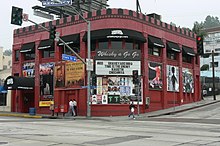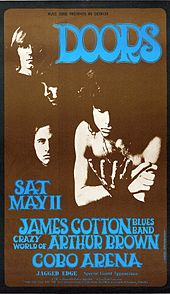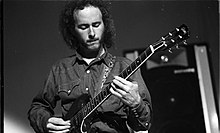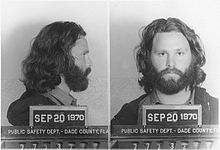The Doors theme by MrToffee
Download: TheDoors.p3t

(8 backgrounds)
The Doors | |
|---|---|
 The Doors in 1966: Jim Morrison (left), John Densmore (center), Robby Krieger (right) and Ray Manzarek (seated) | |
| Background information | |
| Origin | Los Angeles, California |
| Genres | |
| Discography | The Doors discography |
| Years active |
|
| Labels | |
| Spinoffs |
|
| Spinoff of | Rick & the Ravens |
| Past members | |
| Website | thedoors |
The Doors were an American rock band formed in Los Angeles in 1965, conmprising vocalist Jim Morrison, keyboardist Ray Manzarek, guitarist Robby Krieger and drummer John Densmore. They were among the most influential and controversial rock acts of the 1960s, primarily due to Morrison's lyrics and voice, along with his erratic stage persona and legal issues. The group is widely regarded as an important figure of the era's counterculture.[4]
The band took its name from the title of English writer Aldous Huxley's book The Doors of Perception, itself a reference to a quote by English poet William Blake. After signing with Elektra Records in 1966, the Doors with Morrison recorded and released six studio albums in five years, some of which are generally considered among the greatest of all time,[5][6] including their debut The Doors (1967), Strange Days (1967), and L.A. Woman (1971). Dubbed the "Kings of Acid Rock",[7] they were one of the most successful bands of their time and by 1972, the Doors had sold over 4 million albums domestically and nearly 8 million singles.[8]
Morrison died in uncertain circumstances in 1971. The band continued as a trio, releasing three more albums in the 1970s, one of which featured earlier recordings by Morrison, until disbanding in 1973.[9][10] They reunited briefly in 1993 when they were inducted into the Rock and Roll Hall of Fame, and for several one-off projects in the 21st century. In 2002, Manzarek, Krieger, and Ian Astbury of the Cult on vocals started performing as "The Doors of the 21st Century". Densmore and the Morrison estate successfully sued them over the use of the band's name. After a short time as Riders on the Storm, they settled on the name Manzarek–Krieger and toured until Manzarek's death in 2013.
The Doors were the first American band to accumulate eight consecutive Gold LPs.[nb 1] According to the Recording Industry Association of America (RIAA), they have sold 34 million albums in the United States[12] and over 100 million records worldwide,[13] making them one of the best-selling bands of all time.[14] The Doors have been listed as one of the greatest artists of all time by magazines including Rolling Stone, which ranked them 41st on its list of the "100 Greatest Artists of All Time".[15] In 1993, they were inducted into the Rock and Roll Hall of Fame.
History[edit]
Origins (July 1965 – August 1966)[edit]

The Doors began with a chance meeting between acquaintances Jim Morrison and Ray Manzarek on Venice Beach in July 1965. They recognized each other as they had both attended the UCLA School of Theater, Film and Television. Morrison confided in Manzarek that he had been writing songs.[16] As Morrison would later relate to Jerry Hopkins in Rolling Stone, "Those first five or six songs I wrote, I was just taking notes at a fantastic rock concert that was going on inside my head. And once I'd written the songs, I had to sing them."[17] With Manzarek's encouragement, Morrison sang the opening words of "Moonlight Drive": "Let's swim to the moon, let's climb through the tide, penetrate the evening that the city sleeps to hide." Manzarek was inspired, thinking of the music he could play to accompany these "cool and spooky" lyrics.[18]
Manzarek was then in an unsuccessful band called Rick & the Ravens with his brothers Rick and Jim, while drummer John Densmore was playing with the Psychedelic Rangers and knew Manzarek from meditation classes.[19] Densmore joined the group later in August 1965. Together, they combined varied musical backgrounds, from jazz, rock, blues, and folk music idioms.[20] The five, along with bass player Patty Sullivan,[nb 2] and now christened the Doors, recorded a six-song demo on September 2, 1965, at World Pacific Studios in Los Angeles.[nb 3] The band took their name from the title of Aldous Huxley's book The Doors of Perception, itself derived from a line in William Blake's The Marriage of Heaven and Hell: "If the doors of perception were cleansed, everything would appear to man as it is: infinite".[23][24] In late 1965, after Manzarek's two brothers left, guitarist Robby Krieger joined.[25]

From February to May 1966, the group had a residency at the "rundown" and "sleazy" Los Angeles club London Fog, appearing on the bill with "Rhonda Lane Exotic Dancer".[26] The experience gave Morrison confidence to perform in front of a live audience, and the band as a whole to develop and, in some cases, lengthen their songs and work "The End" and "Light My Fire" into the pieces that would appear on their debut album.[26] Manzarek later said that at the London Fog the band "became this collective entity, this unit of oneness ... that is where the magic began to happen."[26] The group soon graduated to the more esteemed Whisky a Go Go after being booked by Ronnie Haran,[27] where they were the house band (starting from May 1966), supporting acts, including Van Morrison's group Them.[28] On their last night together the two bands joined up for "In the Midnight Hour" and a twenty-minute jam session of "Gloria".[29][30]
On August 10, 1966, they were spotted by Elektra Records president Jac Holzman, who was present at the recommendation of Love singer Arthur Lee, whose group was with Elektra Records. After Holzman and producer Paul A. Rothchild saw two sets of the band playing at the Whisky a Go Go, they signed them to the Elektra Records label on August 18 — the start of a long and successful partnership with Rothchild and sound engineer Bruce Botnick. The Doors were fired from the Whisky on August 21, 1966, when Morrison added an explicit retelling and profanity-laden version of the Greek myth of Oedipus during "The End".[31]
The Doors and Strange Days (August 1966 – December 1967)[edit]

The Doors recorded their self-titled debut album around August 1966, at Sunset Sound Studios.[32] The record was officially released in the first week of January 1967. It included many popular songs from their repertory, among those, the nearly 12-minute musical drama "The End".[33] In November 1966, Mark Abramson directed a promotional film for the lead single "Break On Through (To the Other Side)". The group also made several television appearances, such as on Shebang, a Los Angeles television show, miming to a playback of "Break On Through".[nb 4] In early 1967, the group appeared on The Clay Cole Show (which aired on Saturday evenings at 6 p.m. on WPIX Channel 11 out of New York City) where they performed their single "Break On Through". Since the single acquired only minor recognition, the band turned to "Light My Fire"; it became the first single from Elektra Records to reach number one on the Billboard Hot 100 singles chart, selling over one million copies.[36]
From March 7 to 11, 1967, the Doors performed at the Matrix Club in San Francisco. The March 7 and 10 shows were recorded by Peter Abram, co-owner of the Matrix. These recordings are notable as they are among the earliest live recordings of the band to circulate. On November 18, 2008, the Doors published a compilation of these recordings, Live at the Matrix 1967, on the band's boutique Bright Midnight Archives label.[37][38]
On August 25, 1967, they appeared on American television, guest-starring on the variety TV series Malibu U, performing "Light My Fire", though they did not appear live. The band is seen on a beach and Morrison is lip-synching the song in playback.[39] The music video did not gain any commercial success and the performance fell into relative obscurity.[40] It was not until they appeared on The Ed Sullivan Show that they gained attention on television.[41]
The Doors made their international television debut on October 16, 1967, performing a live version of "The End" for the Canadian Broadcasting Corporation (CBC) at their Parliament Street Colour Studio in Toronto.[42] It was recorded in September when they were in Toronto and transmitted on the show O'Keefe Centre Presents. The misconception that it was at the O'Keefe Centre stems mostly from the title, as the venue shown in the video has a dance floor, which the Centre didn't have.[42] But after its initial broadcasts, the performance remained unreleased except in bootleg form until the release of The Doors Soundstage Performances DVD in 2002.[43]
On September 17, 1967, the Doors gave a memorable performance of "Light My Fire" on The Ed Sullivan Show.[41] According to Manzarek, network executives asked that the word "higher" be removed, due to a possible reference to drug use.[44] The group appeared to acquiesce, but performed the song in its original form, because either they had never intended to comply with the request or Jim Morrison was nervous and forgot to make the change (the group has given conflicting accounts).[45][46] Either way, "higher" was sung out on national television, and the show's host, Ed Sullivan, canceled another six shows that had been planned. After the program's producer told the band they would never perform on the show again,[44] Morrison reportedly replied: "Hey man. We just did the Sullivan Show."[41][47][48]
On December 24, the Doors performed "Light My Fire" and "Moonlight Drive" live for The Jonathan Winters Show. Their performance was taped for later broadcast. From December 26 to 28, the group played at the Winterland Ballroom in San Francisco; during one set, in the middle of "Back Door Man", the band stopped performing to watch themselves on The Jonathan Winters Show on a television set wheeled onto the stage.[49][50]

The Doors spent several weeks in Sunset Studios in Los Angeles recording their second album, Strange Days, experimenting with the new technology, notably the Moog synthesizer they now had available.[51] The commercial success of Strange Days was middling, peaking at number three on the Billboard album chart but quickly dropping, along with a series of underperforming singles.[36] The chorus from the album's single "People Are Strange" inspired the name of the 2009 documentary of the Doors, When You're Strange.[23]
Although session musician Larry Knechtel had occasionally contributed bass on the band's debut album,[52] Strange Days was the first Doors album recorded with a studio musician, playing bass on the majority of the record, and this continued on all subsequent studio albums.[53] Manzarek explained that his keyboard bass was well-suited for live situations but that it lacked the "articulation" needed for studio recording.[53] Douglass Lubahn played on Strange Days and the next two albums; but the band used several other musicians for this role, often using more than one bassist on the same album. Kerry Magness, Leroy Vinnegar, Harvey Brooks, Ray Neopolitan, Lonnie Mack, Jerry Scheff,[54] Jack Conrad (who played a major role in the post Morrison years touring with the group in 1971 and 1972), Chris Ethridge, Charles Larkey and Leland Sklar are credited as bassists who worked with the band.[55][56]
New Haven incident (December 1967)[edit]

On December 9, 1967, the Doors performed a now-infamous concert at New Haven Arena in New Haven, Connecticut, which ended abruptly when Morrison was arrested by local police.[57] Morrison became the first rock artist to be arrested onstage during a live performance.[58][59] Prior to the start of the concert, Morrison was either having a private conversation with[60] or kissing a female fan backstage in a bathroom shower stall when a police officer happened upon them.[61] Unaware that he was the lead singer of the band, the officer told Morrison and the fan to leave, to which Morrison said, "Eat it." The policeman took out a can of mace and warned Morrison, "Last chance", to which Morrison replied, "Last chance to eat it."[62][63] There is some discrepancy as to what happened next: according to No One Here Gets Out Alive, the fan ran away and Morrison was maced; but Manzarek recounts in his book that both Morrison and the fan were sprayed.[62][64][65]
The Doors' main act was delayed for an hour while Morrison recovered, after which the band took the stage very late. According to music journalist Gillian G. Gaar, the police still did not consider the issue resolved and wanted to charge him. Halfway through the first set, Morrison proceeded to create an improvised song about his experience with the "little man in blue".[60] It was an obscenity-laced account to the audience, describing what had happened backstage and taunting the police, who were surrounding the stage.[66][67] Later, the police lieutenant approached Morrison, during which Morrison thrust the microphone against his mouth and remarked, "Say your thing, man."[61][66] The concert came to an abrupt end when Morrison was dragged from the stage by the police. The audience, already restless from waiting so long for the band to perform, became unruly. Morrison was taken to a local police station, photographed and booked on charges of inciting a riot, indecency and public obscenity. Charges against Morrison, as well as those against three journalists also arrested in the incident (Mike Zwerin, Yvonne Chabrier and Tim Page), were dropped several weeks later for lack of evidence.[59][64]
Waiting for the Sun (April–December 1968)[edit]

Recording of the group's third album in April 1968 was marred by tension as a result of Morrison's increasing dependence on alcohol and the rejection of the 17-minute "Celebration of the Lizard" by band producer Paul Rothchild, who considered the work not commercial enough.[68] Approaching the height of their popularity, the Doors played a series of outdoor shows that led to frenzied scenes between fans and police, particularly at Chicago Coliseum on May 10.[69]
The band began to branch out from their initial form for this third LP, and began writing new material. Waiting for the Sun became their first and only album to reach number 1 on the US charts, and the single "Hello, I Love You" (one of the six songs performed by the band on their 1965 Aura Records demo) was their second US No. 1 single. Following the 1968 release of "Hello, I Love You", the publisher of the Kinks' 1964 hit "All Day and All of the Night" announced they were planning legal action against the Doors for copyright infringement; however, songwriter Ray Davies ultimately chose not to sue.[70][nb 5] Kinks guitarist Dave Davies was particularly irritated by the similarity.[72] In concert, Morrison was occasionally dismissive of the song, leaving the vocals to Manzarek, as can be seen in the documentary The Doors Are Open.[73]

A month after a riotous concert at the Singer Bowl in New York City, the group flew to Great Britain for their first performance outside North America. They held a press conference at the ICA Gallery in London and played shows at the Roundhouse. The results of the trip were broadcast on Granada TV's The Doors Are Open, later released on video. They played dates in Europe, along with Jefferson Airplane, including a show in Amsterdam where Morrison collapsed on stage after a drug binge (including marijuana, hashish and unspecified pills).[74]

The group flew back to the United States and played nine more dates before returning to work in November on their fourth LP. They ended the year with a successful new single, "Touch Me" (released in December 1968), which reached No. 3 on the Billboard Hot 100 and No. 1 in the Cashbox Top 100 in early 1969; this was the group's third and last American number-one single.[75]
Miami incident (March 1969)[edit]

On March 1, 1969, at the Dinner Key Auditorium in the Coconut Grove neighborhood of Miami, Florida, the Doors gave the most controversial and consequential performance of their career, one that nearly "derailed the band".[9] The auditorium was a converted seaplane hangar that had no air conditioning on that hot night, and the seats had been removed by the promoter to boost ticket sales.[76][77]
Morrison had been drinking all day and had missed connecting flights to Miami. By the time he arrived, drunk, the concert was over an hour late.[76][78] The restless crowd of 12,000, packed into a facility designed to hold 7,000, was subjected to undue silences in Morrison's singing, which strained the music from the beginning of the performance. Morrison had recently attended a play by an experimental acting company the Living Theatre and was inspired by their "antagonistic" style of performance art.[79][80] Morrison taunted the crowd with messages of both love and hate, saying, "Love me. I can't take it no more without no good love. I want some lovin'. Ain't nobody gonna love my ass?" and alternately, "You're all a bunch of fuckin' idiots!" and "You’re all a bunch of slaves!"[81] while screaming "What are you gonna do about it?" over and over again.[80][82][78]
As the band began their second song, "Touch Me", Morrison started shouting in protest, forcing the band to a halt. At one point, Morrison removed the hat of an onstage police officer and threw it into the crowd; the officer reacted by taking Morrison's hat and throwing it in the same direction.[83][84] Manager Bill Siddons recalled, "The gig was a bizarre, circus-like thing, there was this guy carrying a sheep and the wildest people that I'd ever seen."[85] Equipment chief Vince Treanor said, "Somebody jumped up and poured champagne on Jim so he took his shirt off, he was soaking wet. 'Let's see a little skin, let's get naked,' he said, and the audience started taking their clothes off."[85] Having removed his shirt, Morrison held it in front of his groin area and started to make hand movements behind it.[86] Manzarek described the incident as a mass "religious hallucination".[86]
On March 5, the Dade County Sheriff's office issued a warrant for Morrison's arrest, claiming Morrison had exposed his penis while on stage, shouted obscenities to the crowd, simulated oral sex on Krieger, and was drunk at the time of his performance. Morrison turned down a plea bargain that required the Doors to perform a free Miami concert. He was convicted and sentenced to six months in jail with hard labor, and ordered to pay a $500 fine.[87][88] Morrison remained free, pending an appeal of his conviction, and died before the matter was legally resolved. In 2007 Florida Governor Charlie Crist suggested the possibility of a posthumous pardon for Morrison, which was announced as successful on December 9, 2010.[89] Densmore, Krieger and Manzarek have denied the allegation that Morrison exposed himself on stage that night.[90][91][92][93]
